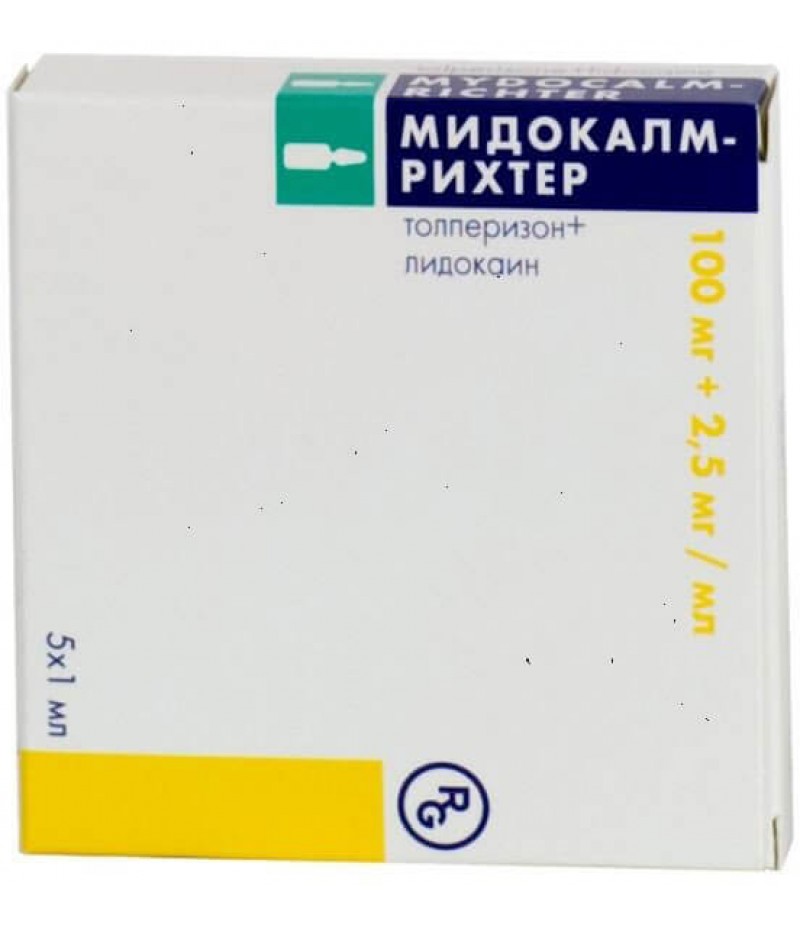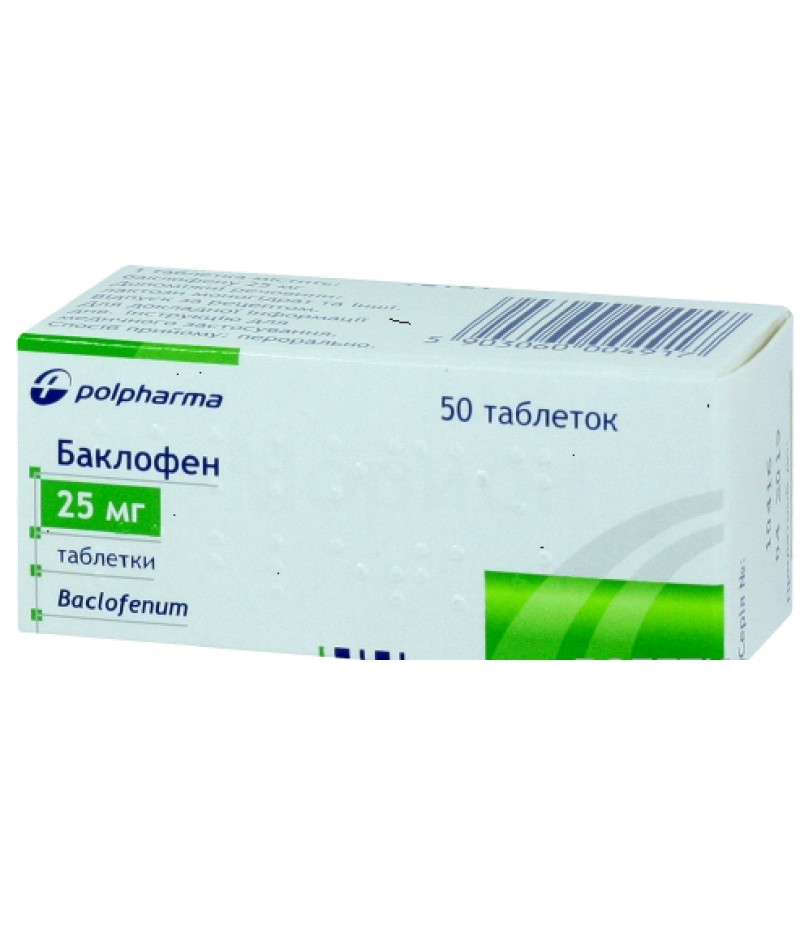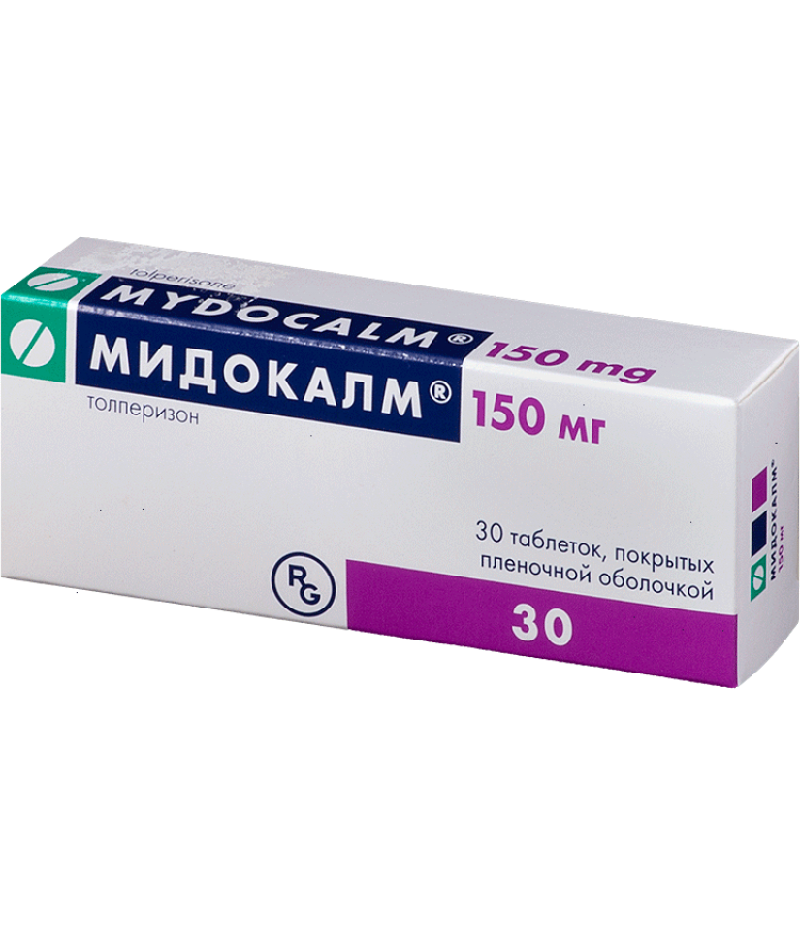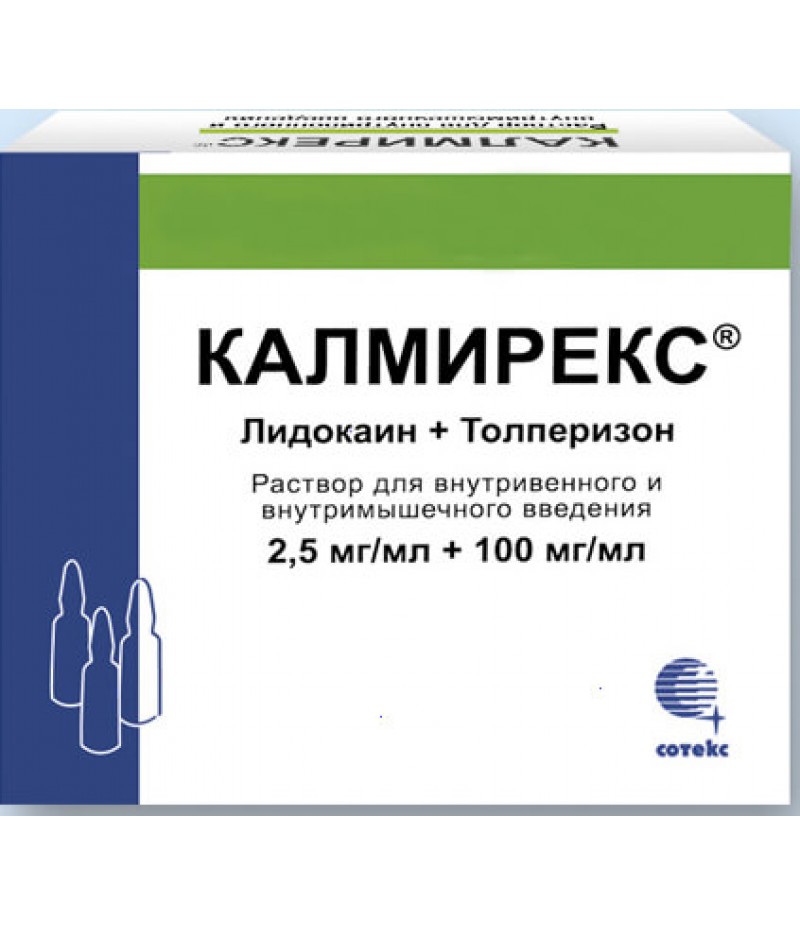Mydocalm-Richter solution 100+2.5mg/ml 1ml #5
- $27.53
- 3 or more $27.20
- Availability:In Stock
Mydocalm-Richter user manualReed more and buy Mydocalm-Richter on this pageCompositionThe formulation of the solution for injections Mydocalm-Richter includes the active components of Tolperisone Hydrochloride and Lidocaine Hydroc..
Tags: solution
Mydocalm-Richter user manual
Reed more and buy Mydocalm-Richter on this page
Composition
The formulation of the solution for injections Mydocalm-Richter includes the active components of Tolperisone Hydrochloride and Lidocaine Hydrochloride, as well as auxiliary substances:
methylparahydroxybenzoate (preservative E218);
diethyleneglycol ether monoethyl;
water for injections.
Form of issue
The drug is available in ampoules of 1 ml in the form of a solution for intravenous and intramuscular injection. One cardboard package contains a plastic pallet with 5 ampoules and instructions for the use of the solution for injection Mydocalm.
The solution has the form of a transparent colorless (or slightly greenish) liquid with a characteristic specific odor.
pharmachologic effect
The drug belongs to the pharmacotherapeutic group "Miorelaxants (muscle relaxants) with a central mechanism of action" and is characterized by the ability to provide:
local anesthetic;
myorelaxing;
membrane-stabilizing effects.
Pharmacodynamics and pharmacokinetics
The mechanism of action of the Tolpeperisone solution is not fully understood. It is known that the substance is characterized by high affinity (from Latin affinitas - "kinship") to the nervous tissue. Its highest concentrations are noted in the cerebral trunk, spinal cord and PNS (peripheral nervous system).
The most significant is the ability of Tolperisone to exert a retarding effect on the reflex centers in the spinal cord. It is likely that a similar effect in combination with an inhibitory effect on efferent (descending) pathways determines the therapeutic effect of Tolperisone.
Tolperisone has the ability to prevent the destruction of cell membranes, and also reduces the indices of electrical excitability of motor (motor) neurons and primary afferent processes of nerve cells that conduct sensitive impulses from various tissues and organs to the CNS (central nervous system).
In addition, the substance:
reduces the threshold of pain sensitivity;
blocks spinal-stem monosynaptic and polysynaptic reflexes;
selectively reduces the activity of the caudal part of the complex of nerve structures localized in the central sections of the brain stem capillary covering throughout its entire length (the so-called reticular formation of the brainstem);
reduces spasticity of muscles;
reduces pathologically hypertonic musculature;
reduces muscle rigidity;
reduces the intensity of pain;
facilitates arbitrary active movements and increases their amplitude;
intensifies the intensity of peripheral blood flow;
has a vasodilating effect;
prevents the release of mediators in the synapses (a similar effect develops, most likely, again, due to inhibition of the processes of calcium ions (Ca2 +) entering the presynaptic (nerve) endings).
Tolperisone has a weak spasmolytic effect and has properties of the H-anticholinergic of the central action.
This is expressed in the ability of the substance to prevent or reduce predominantly the nicotine-like action of acetylcholine (the main neurotransmitter in the parasympathetic nervous system) and cholinomimetic agents.
At that, Tolperizon does not exert a pronounced effect on the peripheral parts of the nervous system.
Tolperisone is characterized by good tolerability (in particular, it is well tolerated by elderly patients), does not provoke the development of cardiotoxic effects and cognitive impairment, is devoid of sedation.
The safety profile of Tolperisone is based on data from clinical trials in which patients with muscle hypertension of various etiologies participated, as well as on the basis of spontaneous reports of any undesirable reactions.
Preclinical studies of pharmacological safety, toxicity level in course use, genotoxicity (the ability to potentially provoke gene mutations or the development of tumors), the ability to influence the reproductive function of specific risks to patients was not revealed.
Undesirable effects were noted only in those cases when the administered dose significantly exceeded the maximum allowable for a person. The latter indicates a low significance for clinical use.
Lidocaine acts as a local anesthetic and is characterized by the ability to dose-dependently inhibit the activity of Na + channels (potential-dependent sodium channels), which in turn inhibits the generation of pulses in the endings of sensitive nerve fibers and impulses along them. Moreover, the substance suppresses not only the pain impulses, but also the impulses of other modalities.
When topical application provokes vasodilatation, without exerting a local irritant effect.
When dosing the drug Mydocalm-Richter in accordance with the schemes given in the instructions for use, lidocaine does not have a systemic effect on the patient's body.
Tolperisone hydrochloride is intensively biotransformed in the tissues of the liver and kidneys, after which it is almost completely removed from the body by the kidneys in the form of metabolic products (more than 99% of the substance that entered the body). There are no precise data on the pharmacological activity of metabolites.
After the administration of a solution of Mydocalm I / in the half-life of Tolperisone hydrochloride is an hour and a half.
Lidocaine hydrochloride, when ingested, is completely absorbed. And the rate of absorption depends on the place of administration of the drug and its dose. The time for which the maximum concentration of the substance is reached after intramuscular injection varies from half an hour to 45 minutes.
With plasma proteins, lidocaine binds to 50-80%. The distribution of the substance in various tissues and organs occurs quite rapidly.
It has the ability to penetrate the hemato-encephalic (GEB) and plasma barriers and excrete with the breast milk of a nursing woman. And the concentration of lidocaine in milk is 40% of the concentration of the substance in the blood plasma of the mother.
Lidocaine is metabolized in the liver tissues (approximately 90-95%) under the influence of microsomal hepatic enzymes through dealkylation of the amino group and cleavage of the amide bond. As a result of this process, pharmacologically active metabolites are isolated.
From the patient's body lidocaine is excreted together with bile (the substance is partially reabsorbed in the gastrointestinal tract) and kidneys (up to 10% of lidocaine is excreted unchanged).
Indications for use
Indications for use Mydocalm-Richter:
hypertonicity and spasticity of skeletal muscle tissue caused by organic lesions of the central nervous system (stroke, damage to the pyramidal system, damage to the spinal cord of various etiologies, multiple sclerosis, inflammation of the brain and spinal cord of toxic-allergic or viral etiology, etc.);
hypertonicity and spasticity of skeletal muscle tissue due to lesions of the musculoskeletal system (dystrophic processes of the anatomical structures of the spine, large joint arthrosis, spinal spondyloarthrosis, cervico-brachial neuralgia, lumbar syndrome, etc.);
diseases accompanied by muscular dystonia;
Restorative therapy after surgery (orthopedic, traumatological, surgical).
In combination with other therapeutic measures, Mydocalm in ampoules is recommended:
patients with pathology associated with vasodilatation (diabetic angiopathy, obliterating atherosclerosis, diffuse scleroderma, Raynaud's syndrome, etc.);
patients with pathologies due to disorders of vascular innervation (eg, acrocyanosis).
Contraindications
Contraindications to the appointment of Mydocalm-Richter are:
hypersensitivity to any of the active or auxiliary substances included in the preparation (including lidocaine and other amide preparations with a local anesthetic effect);
myasthenia gravis in severe form;
pregnancy;
lactation.
Also, the drug has age limits: injections of drugs are contraindicated in persons under the age of 18 years.
Side effects
Most often the patient's body reacts to the injections of Midokalma by flushing the skin at the injection site.
Such individual reactions as:
anorexia;
sleep disorders;
headaches and dizziness, excessive drowsiness;
arterial hypotension;
dyspeptic and diarrheal disorders;
weakness and soreness of the muscles, pain in the limbs;
symptoms of asthenic syndrome, a feeling of general discomfort, increased fatigue.
The rarely occurring adverse reactions that occur less frequently than in one case from a thousand, but more often than once per ten thousand cases, are:
hypersensitivity reactions;
depression, decreased physical activity;
attention disorders, convulsions, excessive drowsiness, hypoesthesia, tremor, etc .;
visual impairment;
noise in ears; loss of balance, accompanied by a feeling of rotation of one's own body around objects or vice versa - by rotating objects around the body;
heart palpitations, stenocardia, lower blood pressure indicators;
hyperemia of the skin;
nosebleeds, difficulty breathing, shortness of breath;
abdominal pain, constipation, flatulence, vomiting;
liver damage (usually in mild form);
skin reactions (itching, burning, increased sweating, the appearance of rashes, etc.);
urinary incontinence, increased concentration of protein in the urine (in excess of the physiological norm);
increased irritability, strong thirst, the appearance of a feeling of intoxication;
change in the values of laboratory indicators (changes in the concentration of bilirubin contained in the blood, disruption of the activity of liver enzymes, etc.).
In single cases, the following are possible:
anaphylactic shock;
enlarged lymph nodes;
unnaturally strong, unquenchable thirst;
confusion of consciousness;
decrease in cardiac rhythm (up to a frequency of less than 55 beats per minute);
osteopenia;
an increase in the concentration of creatinine in the blood.
Instructions for use Mydocalm-Richter: method of application and dosage of the drug
According to the instructions for use, the injections of Mydocalm are shown only to patients over 18 years of age. The solution is injected parenterally into a vein or muscle.
Intramuscular injections involve administering to the patient twice a day a dose equal to 100 mg of Tolperisone (the contents of one ampoule).
The drug should be administered once a day at a dose equal to 100 mg of Tolperisone, very slowly.
How many days to puncture Mydocalm-Richter, determines the attending physician, depending on the severity of the disease and the patient's response to the prescribed therapy.
The experience of treating patients with impaired liver and / or kidney function is limited. However, in this group of patients, undesirable events associated with the use of Midokalma are noted more often than in patients with healthy liver / kidneys.
For this reason, for patients with moderate renal and / or liver lesions, the optimal dose of the drug is selected individually by titration. It is recommended that you carefully monitor the patient's condition and all changes in the liver / kidney function.
Patients with severe forms of liver and / or kidney disease Tolperizon contraindicated.
Overdose
Data on cases of overdose by Mydocalm are limited. The drug is characterized by a wide therapeutic index.
According to the data of preclinical studies of acute toxicity of the solution, when the drug is administered in doses substantially exceeding the therapeutic dose, symptoms such as:
disorders of coordination of movements of various muscles against the background of the patient's lack of muscle weakness (ataxia);
tonic-clonic seizures;
difficulty breathing (until its complete stop).
There is no specific antidote for Tolmerozon. When exceeding the recommended dose, it is recommended that the patient is washed with the stomach. Symptomatic and supportive therapies are shown below.
Interaction
There is no data on the compatibility study of Mydocalm, therefore, before administration, the solution should not be mixed in one syringe with other medicines. The drug is administered separately from other medicines.
Despite the fact that Mydocalm-Richter is characterized by the ability to exert influence on the central nervous system, there is no chance of developing a sedative effect when it is used. It is possible to prescribe the drug in combination with sedatives, hypnotics, as well as about the means, which include alcohol.
Does not affect the effect of alcohol on the central nervous system.
If you need Mydocalm-Richter in combination with other central muscle relaxants, consider lowering the daily dose of Tolperisone.
Tolperisone potentiates the pharmacological action of niflumic acid and other non-steroidal anti-inflammatory drugs, which is why the dose of the latter with simultaneous reception with Tolmerozon is recommended to be reduced.
Pharmacological effects of Tolperisone are enhanced by the following drugs:
means for general anesthesia;
muscular relaxants of peripheral action;
psychotropic drugs;
clonidine.
Terms of sale
You don't need a prescription to buy Mydocalm solution.
Storage conditions
Store the solution in its original packaging in areas hard to reach for children, observing the temperature regime from 8 to 15 ° C.
Shelf life - 3 years after the date of manufacture.
special instructions
Care should be taken during the treatment with the drug Mydocalm-Richter when driving and performing the risks associated with health and life, as well as work that requires an increased concentration of attention and a high rate of psychomotor reactions.
Appointment of injections of Mydocalm to pregnant and lactating women
Animal studies have shown that Tolperisone does not have a negative effect on intrauterine development of the fetus. Nevertheless, to date, data on the harmlessness of the drug for the treatment of pregnant and lactating women are not available.
The drug in the form of a solution for injection is contraindicated in the first trimester. Its appointment is possible at a later date, but only when, according to the doctor, the expected therapeutic effect for a woman exceeds the risk of complications for the fetus or baby.
Since it is not known exactly whether Tolperisone can penetrate into breast milk, the use of the drug during breastfeeding is contraindicated. If you do not manage to avoid the appointment of the injections of Mydocalm-Richter, the question of stopping lactation should be solved for the duration of the course of treatment.
Reviews of Mydocalm-Richter
The drug is successfully used to treat patients in many countries around the world. It is characterized by good tolerability, does not have a sedative effect, which is confirmed by numerous randomized studies that used a placebo.
Reviews about the injections of Mydocalm-Richter left by the patients are overwhelmingly positive. The drug is described as an effective and affordable drug. Only occasionally can you find negative reviews, which state the ineffectiveness of treatment by injections of Mydocalm.
Some people note that the greatest effectiveness in the treatment of certain diseases (in particular, osteochondrosis) was achieved using Medocals in combination with other medicines.
Doctors confirm this opinion and often prescribe injections of Mydocalm in combination with vitamin preparations of fortifying action (for example, Milgamma or Kombilipen) and non-steroidal anti-inflammatory drugs (for example, Movalis).




